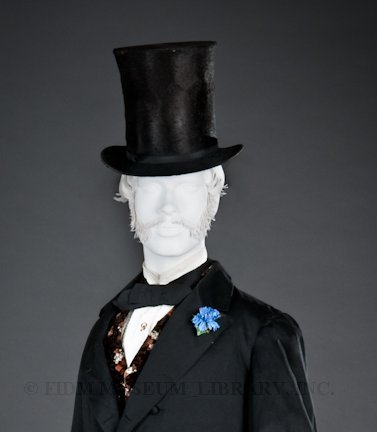In the mid-nineteenth century, a gentleman of distinction wouldn't have dared to leave his house without a hat. The most popular style of men's hat was the glossy, silk plush top hat, sometimes called a chimney pot or stovepipe. Equated with authority and success, top hats were worn by the aristocracy, bankers, reputable businessman and politicians. Because of these authoritative associations, top hats were also worn by ambitious men of the lower classes who hoped to make their way in the world. Workers charged with keeping order, including stationmasters and male servants, often wore top hats as part of their professional uniform. Unlike today's top hat, which is worn only in a few formal situations, top hats were an everyday component of the masculine wardrobe.
 Top hat
Top hat
c. 1855-60
Museum Purchase
2010.5.13
The 1850s witnessed the tallest top hats of the century. The top hat pictured above is about 8 inches tall, a typical height for the decade. Straight sides and a moderately curved brim also help date the hat to the later part of the 1850s. Though the height and shape of the hat varied somewhat throughout the century, the overall silhouette remained constant. Two more 1850s top hats can be seen in our recent post on conserving an 1850s ambrotype.
The gloss and texture of the silk plush fabric seen above mimics the appearance of felted fur. Until the 1830s, many hats were made of felted beaver fur. The demand for warm and waterproof beaver pelts pushed the species to near extinction by the 1830s. About this same time, a French textile mill developed a silk plush fabric that closely resembled the appearance of felted fur. This new textile became popular for use in top hats, possibly saving beavers from total extinction. Once silk plush became popular, only the most expensive top hats were still made from fur. Summer top hats were sometimes made from woven straw.
By the end of the 19th century, the top hat was losing ground to other types of headwear. The bowler or derby hat, with its low, rounded crown and upturned brim, was especially popular. Not only was the top hat impractically high, but sociocultural changes meant that its close association with the ruling class was no longer so desirable. By the end of World War I, top hats were worn only for formal or ceremonial situations. Today, top hats are rarely worn, except at formal weddings. This image from the recent wedding of Kate Middleton and Prince William features soccer star David Beckham holding his top hat as he enters Westminster Abbey.

